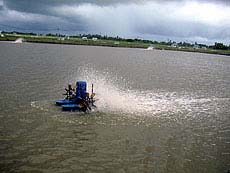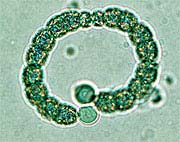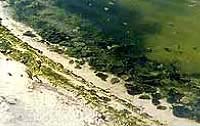Water Plankton – Microscopic
Maintaining Plankton Blooms & Water Color in Shrimp Pond.
As already mentioned the plankton bloom is essential to successful shrimp culture. The bloom consists of a complex variety of organisms, including both microscopic plants (phytoplankton) and animals (Zooplankton). It is impossible to cover all the individual variations that can occur in the composition of the bloom, all we will try to do here is to give general guidelines.
 As a general rule green or yellow-green blooms are easier to maintain than brown blooms. As the average age of bloom increases there tends to be a progressive darkening of the color. In some cases a green phytoplankton may become brown as it ages. In lower salinities (<20 ppt) the plankton tends to be composed of a relatively high number of species and is more likely to be green in color. In higher salinities (>25 ppt) there will probably be fewer species present and the color is more likely to be brown. There are only general rules and there are many exceptions. It is difficult to give specific advice regarding the relative suitability of different species of plankton due to the vast range of species.
As a general rule green or yellow-green blooms are easier to maintain than brown blooms. As the average age of bloom increases there tends to be a progressive darkening of the color. In some cases a green phytoplankton may become brown as it ages. In lower salinities (<20 ppt) the plankton tends to be composed of a relatively high number of species and is more likely to be green in color. In higher salinities (>25 ppt) there will probably be fewer species present and the color is more likely to be brown. There are only general rules and there are many exceptions. It is difficult to give specific advice regarding the relative suitability of different species of plankton due to the vast range of species.
During the earlier part of the production cycle (up 4 – 6 weeks) the most common causes of plankton crashes are lack of nutrients or lack of CO2. This may resulting the bloom crashing dramatically leaving very few viable plankton in the water. The dead plankton may cause large amounts of stable foam on the surface of the pond and will also lead to the accumulation of material on the pond bottom. In this case the water may retain some color (green or brown) but it will be very transparent.
Later in the cycle problems are more often associated with blooms that are too dense. If the plankton is very dense and water is not turned over regularly some of the plankton will die due to lack of sunlight. This is less likely to a sudden mass die off of the plankton. More often there is a gradual death of plankton leading to foam on the surface and some debris on the pond bottom but the water will retain a significant quality of plankton.
Plankton may also die later in the cycle due to sudden change in water quality. If a substantial proportion of the water is changed or if there is heavy rain, the water quality in the ponds may alter dramatically, leading to a sudden severe crash of the bloom with the same appearance as a crash in the early stages of culture.
 In order to maintain a healthy bloom it is necessary to supply sufficient nutrients, CO2 and sunlight. The nutrients can be supplied in the form of fertilizer (organic and inorganic), from the shrimp food and from the shrimp waste. CO2 is supplied from the atmosphere, the shrimp, the respiration of the plankton, the carbonate buffer in the water and most importantly from liming. Adequate penetration of sunlight can be ensured by turning the water over regularly and diluting the plankton with new water.
In order to maintain a healthy bloom it is necessary to supply sufficient nutrients, CO2 and sunlight. The nutrients can be supplied in the form of fertilizer (organic and inorganic), from the shrimp food and from the shrimp waste. CO2 is supplied from the atmosphere, the shrimp, the respiration of the plankton, the carbonate buffer in the water and most importantly from liming. Adequate penetration of sunlight can be ensured by turning the water over regularly and diluting the plankton with new water.
The Importance of Water Color
 Although the true function and benefit of one color vs. another is difficult to tell, the intensity and liveliness of the color, actually indicating the condition of phytoplankton growth, are thought to be more pertinent than the variety of colors per se. The appearance of light and lively water color indicates the phytoplankton cells to be young and actively growing, whilst the dull and dark color reflects aged cells with slow growth. Grayish tint in any color indicates an inactive phytoplankton population or a mixture of decayed uneaten feeds or resuspension of bottom mud. The population density can be gauged by the Secchi disk visibility.
Although the true function and benefit of one color vs. another is difficult to tell, the intensity and liveliness of the color, actually indicating the condition of phytoplankton growth, are thought to be more pertinent than the variety of colors per se. The appearance of light and lively water color indicates the phytoplankton cells to be young and actively growing, whilst the dull and dark color reflects aged cells with slow growth. Grayish tint in any color indicates an inactive phytoplankton population or a mixture of decayed uneaten feeds or resuspension of bottom mud. The population density can be gauged by the Secchi disk visibility.
Healthy phytoplankton are known to function as a “nutrient sponge”, soaking up dissolved ammonia, amines, urea, nitrite, nitrate, phosphate, other metabolic wastes from shrimp, and toxic substances, such as heavy metals and pesticides. Furthermore, phytoplankton being able to produce abundant oxygen under sunlight are efficient aerators. The phytoplankton bloom also reduces light penetration, making the shrimps feel more pleasant in the well-shaded pond bottom. Another significant benefit of phytoplankton blooms is to prevent the development of lab-lab in the pond bottom.
Lab-Lab Growth in the Pond Bottom
 The appearance of floating scum’s in shrimp ponds during the first few weeks of the growing cycle is very worrisome to farmers, because the occurrence of those scum’s is often associated with shrimp mortality. What are those scums and what causes them to occur? The scrums in the shrimp ponds appear in two common forms : brownish foams and grayish sheets. The former originates from decomposition of leftover feeds mixed with air bubbles, and t he latter from lab-lab growth on the pond bottom. Microscopic examination reveals that lab-lab is made up of a large number of filamentous blue-green algae, diatoms, bacteria, protozoas, etc. Most common algae that appear in the lab-lab are blue-green algae, diatoms, bacteria, protozoas, etc. Most common algae that appear in the lab-lab are blue-green genera of Oscillatoria, Phormidium, Lyngbya, Spirulina, and diatoms of Navicula, Nitzschia, Amphora, Pleurosigma. When the water lacks a phytoplankton bloom and is clear enough to allow sunlight to reach the pond bottom, those bottom algae grow rapidly to form extensive mats (lab-lab) cemented by a gelatinous substance. Once the pond bottom is covered by a layer of algal mats, the gas and nutrient exchange between overlying water and sediments is greatly reduced, creating an anaerobic environment in the superficial mud below the lab-lab layer. Toxic gases, such as ammonia and hydrogen sulfide, resulting from anaerobic decomposition, are likely to be accumulated in high concentration, particularly in the sediments with rich organic matter. Application of manure fertilizer in shallow water at the beginning of the grow out cycle is likely to worsen this situation. The algal mats in the pond bottom eventually float to the pond surface because of the buoyancy resulting from the anaerobic gases trapped below and the oxygen bubbles on top of the algal mats. Those accumulated toxic gases are presumably released simultaneously with the floating lab-lab, and cause shrimp mortality.
The appearance of floating scum’s in shrimp ponds during the first few weeks of the growing cycle is very worrisome to farmers, because the occurrence of those scum’s is often associated with shrimp mortality. What are those scums and what causes them to occur? The scrums in the shrimp ponds appear in two common forms : brownish foams and grayish sheets. The former originates from decomposition of leftover feeds mixed with air bubbles, and t he latter from lab-lab growth on the pond bottom. Microscopic examination reveals that lab-lab is made up of a large number of filamentous blue-green algae, diatoms, bacteria, protozoas, etc. Most common algae that appear in the lab-lab are blue-green algae, diatoms, bacteria, protozoas, etc. Most common algae that appear in the lab-lab are blue-green genera of Oscillatoria, Phormidium, Lyngbya, Spirulina, and diatoms of Navicula, Nitzschia, Amphora, Pleurosigma. When the water lacks a phytoplankton bloom and is clear enough to allow sunlight to reach the pond bottom, those bottom algae grow rapidly to form extensive mats (lab-lab) cemented by a gelatinous substance. Once the pond bottom is covered by a layer of algal mats, the gas and nutrient exchange between overlying water and sediments is greatly reduced, creating an anaerobic environment in the superficial mud below the lab-lab layer. Toxic gases, such as ammonia and hydrogen sulfide, resulting from anaerobic decomposition, are likely to be accumulated in high concentration, particularly in the sediments with rich organic matter. Application of manure fertilizer in shallow water at the beginning of the grow out cycle is likely to worsen this situation. The algal mats in the pond bottom eventually float to the pond surface because of the buoyancy resulting from the anaerobic gases trapped below and the oxygen bubbles on top of the algal mats. Those accumulated toxic gases are presumably released simultaneously with the floating lab-lab, and cause shrimp mortality.
 It is a common practice to prevent or eliminate lab-lab growth in the pond bottom by increasing the water depth and stimulating phytoplankton growth to prevent light reaching the bottom. Increasing water depth alone may not be totally effective because the lab-lab can develop on the dike slopes where light reaches. Application of inorganic fertilizers to the ponds to stimulate rapid phytoplankton blooms is recommended.
It is a common practice to prevent or eliminate lab-lab growth in the pond bottom by increasing the water depth and stimulating phytoplankton growth to prevent light reaching the bottom. Increasing water depth alone may not be totally effective because the lab-lab can develop on the dike slopes where light reaches. Application of inorganic fertilizers to the ponds to stimulate rapid phytoplankton blooms is recommended.
Factors Which Prevent Phytoplankton Blooms.
Many environmental conditions are required for phytoplankton blooms. The major factors that can prevent phytoplankton from blooming are as follows:
-
Nutrient deficiency
-
Zooplankton predation
-
Unfavorable physical conditions: weather, water changes
The following is the most likely explanation for the absence of phytoplankton blooms in aged shrimp ponds particularly during the start-up stage of shrimp stocking. After shrimp farming has expanded in an area over a number of years, the organic matter gradually saturated the muds and water in the ponds and surrounding environment. The increasing organic matter stimulated bacterial growth, which could easily out-compete phytoplankton in extracting nitrogen and phosphorus in organic and inorganic forms from the water. Bacterial cells are known to be more efficient than phytoplankton in taking up soluble nutrients from the water medium. A blooming development of zooplankton populations followed the increase in bacterial biomass. Those zooplankton fed on bacteria along with the minor phytoplankton. As a result, the phytoplankton never got an opportunity to bloom because of nutrient limitation on the one hand, and zooplankton predation pressure on the other.
Another factor that prevents phytoplankton from blooming is the high rate of water exchange in the shrimp pond. The density of phytoplankton can be reduced if the rate of water exchange exceeds the rate of phytoplankton growth. For example, if the phytoplankton numbers double once every 2-3 days, 30-40% pond water exchange per day can effectively prevent a phytoplankton bloom because of dilution. As light is another essential element needed for phytoplankton growth, lack of sufficient sunlight on the occasion of consecutive rainy or cloudy days can also result in a poor phytoplankton bloom.



